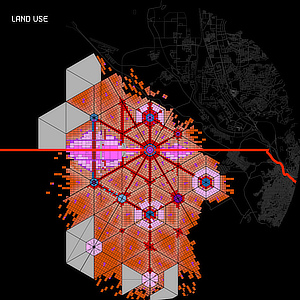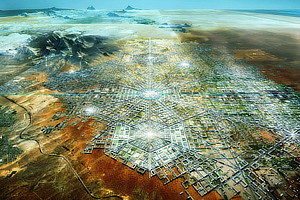 |
 |
 |
 |
 |
 |
| |
 |
|
 |
 |
 |
  |
  |
 |
 |
 |
 |
|
|
 |
|
 |
 |
 |
BUILDING |
 |
|
 |
|
 |
 |
 |
| |
 |
| 
 |
Border City
|
|
 |
 |
 |
 |
DESIGNER |
 |
|
|
 |
|
 |
 |
 |
| |
 |
|
 |
 |
 |
 |
CONTEXT |
 |
|
|
 |
|
 |
 |
 |
| Location |
 |
|
 |
|
 |
 |
 |
 |
 |
 |
 |
DESCRIPTION |
 |
|
|
 |
|
 |
 |
 |
| . |
 |
|
 |
 Fernando Romero’s Border City presents a new vision for a binational city on one of the world’s most important borders, that of the United States and Mexico, whose border states are now home to over 100 million people. Fernando Romero’s Border City presents a new vision for a binational city on one of the world’s most important borders, that of the United States and Mexico, whose border states are now home to over 100 million people.
 The proposal comes at a particularly opportune moment when the issues of immigration, border control, and free trade are being debated around the world, often in provacative and incendiary terms and frequently without the basis of facts. The concept is rooted in the long history of places where frontiers meet, cities where cultures both clash and blend to create something altogether unique, places like Hong Kong, Andorra, Baarle Hertog/Baarle Nassau, and Standstead/ Derby Line. Border City is the rst integrated masterplan for a binational city conducive to both sides of the border, employing tools of enterprise such as special economic zones to argue for its viability. The proposal comes at a particularly opportune moment when the issues of immigration, border control, and free trade are being debated around the world, often in provacative and incendiary terms and frequently without the basis of facts. The concept is rooted in the long history of places where frontiers meet, cities where cultures both clash and blend to create something altogether unique, places like Hong Kong, Andorra, Baarle Hertog/Baarle Nassau, and Standstead/ Derby Line. Border City is the rst integrated masterplan for a binational city conducive to both sides of the border, employing tools of enterprise such as special economic zones to argue for its viability.
To give physical form to the concept, we've situated it between three bordering states of New Mexico, Texas and Chihuahua. The completion of the new inland port of Santa Teresa, the I-10 highway connecting east and west coasts, and the 7 existing border crossings in the area, represents an extraordinary opportunity for logistics and transportation of products in the area.
A united vision draws upon industrial, employment and trade opportunities seen in El Paso and Cuidad Juarez’s economic prosperity, while recognizing shortcomings in the urban planning of the region’s sister cities. Economic, social, cultural and environmental sustainability are urban assets and organizing principles for the proposal’s design. Challenging “border situations” are likely to multiply across the world as populations grow, migration increases, and economies continue to globalize. Romero introduces an urban prototype, with a hexagonal plan, that might offer a new model for a rapidly developing world. |
|
 |
 |
 |
|
 |
|
| . |
 |
|
 |
|
 |
 |
 |
 |
 |
 |
 |
VIDEO |
 |
|
|
 |
|
 |
 |
 |
| |
 |
|
 |
 |
 |
 |
LOCATION |
 |
|
|
 |
|
 |
 |
 |

|
 |

|
Continent |
|
 |
  North America |
|
Nation |
|
 |
  Mexico |
|
State |
|
 |
  Chihuahua |
|
Town |
|
 |
  Border City |
|
|
|
 |
|
 |
 |
 |
 |
MAP |
 |
|
|
 |
|
 |
 |
 |
| |
 |
|
 |
 |
 |
 |
|
TYPOLOGY |
 |
|
|
 |
|
 |
 |
 |
|
|
 |
TOWN PLANNING AND URBAN DESIGN | New settlements
New urban settlement
Urban and territorial planning
Plans on an urban and metropolitan scale
| |
 |
 |
 |
 |
CHRONOLOGY |
 |
|
|
 |
|
 |
 |
 |
Project |
 |
|
 |
| 
 |
2016
|
|
Realisation |
 |
|
 |
| 
 |
2018 - 2030 |
|
 |
 |
 |
 |
EXHIBITIONS |
 |
|
|
 |
|
 |
 |
 |
| |
 |
| Border City in London Design Biennale 2016, London, Somerset House, 7 / 27 september 2016 |
|
 |
 |
 |
 |
 |
 |
 |
STRUCTURES |
 |
|
|
 |
|
 |
 |
 |
| |
 |
Burohappold Engineering
Sabina Uffer |
|
 |
 |
 |
 |
STAFF |
 |
|
|
 |
|
 |
 |
 |
|
 |
|
Design team |
 |
| Fernando Romero, Sergio Rebelo, Unai Artetxe, Jessica Wang, Pedro Ramírez de Aguilar, Gaia Cella, Joao Urbano, Ruoting Wang, Rigel Davila, Francisco Rocha, Yuri Jeong, Qingyi Chen, Aleksandra Lukianova, Romain Thijsen, Luis Torres Lira |
|
Project management |
 |
| Daniela Gallo, Moss Owen Palmer, Nicholas Dolan |
|
Collaborators |
 |
| Dante Baldassin, Tracy Guzikowski, David Forsyth, Filipe Jose Lacerda Neto, Osmin Josue Lopez Avalos, Gabriel Maese, Turku Colak, Cy Kim, Yanni Wang, Yuan Liu, Yueming Zhao, Xiao Gu |
|
Consultant |
 |
Pentagram
Natasha Jen, Veronica Hoglund, Javier Arizu, Rhea Manglapus |
|
 |
 |
 |
 |
CREDITS |
 |
|
|
 |
|
 |
 |
 |
| |
 |
Drawings © fr•ee | Fernando Romero EnterprisE
Text edited by fr•ee | Fernando Romero EnterprisE
Courtesy of fr•ee | Fernando Romero EnterprisE
|
|
 |
  |
 |
|
|